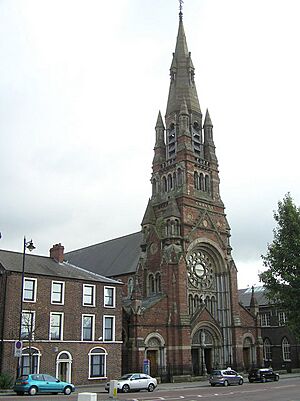St Patrick's Church, Belfast facts for kids
Quick facts for kids Saint Patrick's Church |
|
|---|---|
| Saint Patrick's Church, Belfast | |
 |
|
| Lua error in Module:Location_map at line 420: attempt to index field 'wikibase' (a nil value). | |
| Location | Belfast, County Antrim |
| Country | Northern Ireland |
| Denomination | Catholic |
| Website | St Patrick's Church |
| History | |
| Consecrated | 12 August 1877 |
| Architecture | |
| Architect(s) | Timothy Hevey |
| Style | Gothic Revival |
| Years built | 1875–1877 |
| Specifications | |
| Length | 125 ft |
| Nave width | 32 ft 6 inches |
| Width across transepts | 95 ft x 25 ft |
| Number of spires | 1 |
| Spire height | 180 feet high (54 metre) |
| Administration | |
| Diocese | Down and Connor |
| Province | Armagh |
St. Patrick's Church, Belfast (in Irish: Eaglais Naomh Padraig) is a Catholic church in Belfast, Northern Ireland. It is located in the Donegall Street area. The church is built in the Romanesque Revival style. This means it looks like old Roman buildings. It has a tall tower and a spire at the front.
The first church on this spot opened in 1815. The building you see today opened in 1877. In 2024, only one priest, Eugene O'Neill, serves the parish. This is the first time in over 200 years that the church has had just one priest.
Contents
The First Church Building
Belfast's very first Catholic church was St Mary's. As more Catholic people moved to Belfast in the early 1800s, a new church was needed. Bishop William Crolly decided to build it on land in Donegall Street. This land was set aside for Catholic people in Belfast.
Building the church started in 1811. Many educated Protestants and important people in Belfast helped pay for it. The church was named after Saint Patrick, Ireland's patron saint. It officially opened in 1815.
After the Great Famine, Belfast's Catholic population grew a lot. Even though other churches were built, St. Patrick's needed a much bigger building by the 1870s. The last church service in the old building was on August 1, 1875.
The Current Church Building
The new church, which is the one standing today, was designed by Timothy Hevey. He was a leading Catholic architect in Belfast at that time. The church was built by Collen Brothers, a company from Portadown and Dublin. They built the new church around the old one, then took the old one down.
The new church was designed to hold 2,000 people. It was finished and blessed on August 12, 1877. Archbishop Daniel McGettigan of Armagh, a very important church leader, led the blessing. Bishop Patrick Dorrian, who had worked in the parish earlier, approved the building of this church. He is buried inside the church.
Because the church was so grand, it was chosen for important ceremonies. Several bishops were officially made bishops here. These included Bishops Henry Henry in 1895, John Tohill in 1908, Joseph MacRory in 1915, and Daniel Mageean in 1929.
One special feature is a 7 feet (2.1 m) tall statue of St Patrick above the main door. This statue, like the church's altar, was carved by James Pearse. He was the father of the famous Irish leader, Padraig Pearse. A huge two-ton bell, made by Thomas Sheridan of Dublin, was placed in the 180 feet (55 m) high spire.
St. Patrick's Church is a Grade B+ listed building. This means it is an important historical building. In 2017, reports said the church needed a lot of money for repairs and restoration.
Artwork by Sir John Lavery
The church has a special piece of art called a triptych. A triptych is a painting made of three panels. This artwork was created by Sir John Lavery, who grew up in the parish. He was even baptized in the older, smaller church.
Lavery's triptych is called The Madonna of the Lakes. He used his wife, Hazel Lavery, and his step-daughter as models for the painting. In 1917, Lavery offered to donate a piece of art to the church. The triptych shows Our Lady in the middle, with St Brigid and St Patrick on either side. It was first shown in April 1919.
The artwork used to stand on an altar designed by Edwin Lutyens, a friend of Lavery. It was also lit by two candlesticks designed by Lutyens. Sadly, the altar and candlesticks are now gone. Only the frame around the triptych remains. This frame is the only item designed by Lutyens left in Northern Ireland.
In May 2015, Charles, Prince of Wales (now King Charles III) and his wife Camilla, Duchess of Cornwall visited the church. They came to celebrate St. Patrick's 200th anniversary. They viewed the triptych after a short prayer service.
St. Patrick's School
Next to the church is the renovated St. Patrick's School. It was built in 1828 by Timothy Hevey, who was the father of the architect who designed the church. This was the first Catholic school built in Belfast. The land for the school was given by the Marquess of Donegall.
For many years, the Christian Brothers ran the school. It was a working primary school until 1982. After it closed, it was used for a short time as a community center for the parish. At one point, the church leaders even thought about tearing down the school to make a large car park.
St. Joseph's Church, Sailortown
In August 1880, a second church opened in the parish. This church was closer to the docks area, known as Sailortown. It was named St. Joseph's Church. Bishop Patrick Dorrian opened it. Like many other Catholic buildings in Belfast at that time, Timothy Hevey designed it.
St. Joseph's Church closed in 2001 because fewer people were attending services there.

